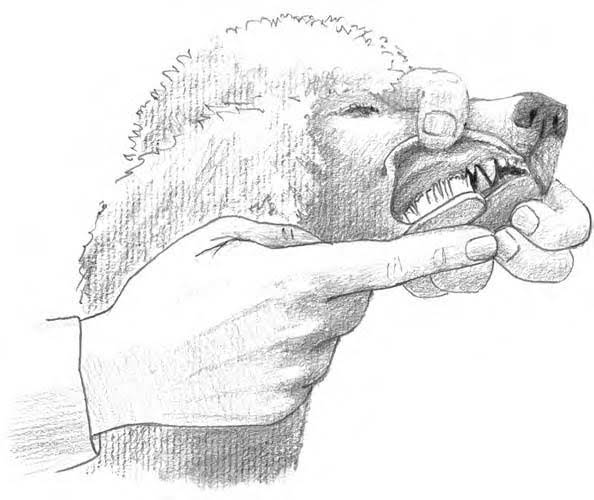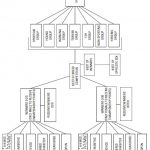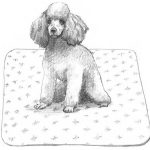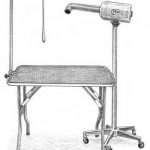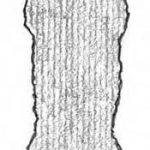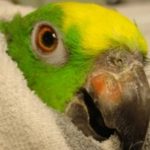In This Chapter
- Outlining a grooming schedule
- Choosing who will groom your Poodle (or grooming yourself)
- Homing in on hair-care concerns
- Styling your Poodle in different clips
- Caring for your Poodle’s nails, eyes, ears, and teeth
I can give you some good news and some bad news about your Poodle’s curly locks. The good news is that Poodles don’t shed. The bad news is that their hair grows continuously. Therefore, grooming is a large part of Poodle care. No matter what size Poodle you own, your dog is definitely not a “wash and wear” breed. This chapter explores all the grooming options for your Poodle pal.
Drawing Up a Grooming Schedule
How often you groom your Poodle — or take her to a professional — depends on the type of clip you want her to have and the length of her hair. For example:
– Any size Poodle sporting a show clip (such as continental or English saddle; see the later section “Showing off with show clips”) needs grooming every four weeks or less.
– A Poodle in a pet clip may be able to go as long as eight weeks, although six weeks is generally the maximum between grooming sessions. (I discuss pet clips in the later section “Keeping it simple with pet clips.”)
Remember
When I say grooming here, I mean a full grooming session: clipping, scissoring, bathing, and brushing. In between your Poodle’s full grooming sessions, you still need to thoroughly brush her, and you also may need to shave her face and feet.
Each Poodle presents different variables that affect grooming schedules. Here’s an example grooming schedule for a Poodle in a pet clip:
– Brushing: Brush your Poodle’s coat thoroughly two to three times a week, depending on coat length. If the trim is very short, and your Poodle has a harsh coat, once a week should do the trick.
Remember
The texture of your Poodle’s coat plays a role in how much grooming attention she needs. The softer the coat, the more likely it is to mat and tangle, meaning you need to groom her more often.
– Bathing: If you take your dog to a professional groomer, he’ll take care of bathing. Otherwise, you should bathe your Poodle before any major clipping or scissoring, or every four to six weeks.
– Clipping: If you want to clip the hair between visits to the groomer, once a month should suffice.
– Nails: Nails grow at different rates, but trimming them once a week is a good idea. See “Trimming your Poodle’s nails” later in this chapter.
– Eyes: Check your Poodle’s eyes at least once a week. If you notice your dog blinking, pawing at her face, or squinting, check her eyes to see if you notice any debris or scratches. See “Keeping an eye on your Poodle’s eyes” later in this chapter.
– Ears: Check your Poodle’s ears weekly. Clean out excess hair, and make sure they aren’t infected. Those lovely earflaps prevent air circulation, providing a perfect atmosphere for yeast infections. Check out “Examining the ears” later in this chapter.
– Teeth: Brush your Poodle’s teeth to keep them shining and healthy. Daily is terrific. Two or three times a week is splendid. Once a week isn’t bad.
A Poodle in a show trim needs more frequent brushing and trimming than a dog in a shorter pet clip. A dog in a short pet clip may need brushing out only once a week, but a dog in a show trim needs a full to-the-skin brushing every two or three days. Depending on how active the Poodle is, she may need brushing every day.
Warning!
If you want to keep your Poodle in show trim, but you don’t want to groom her yourself, make sure you can find a suitable groomer before you start letting that hair grow. Many grooming shops won’t do a show trim on a Poodle. (See the section “Ushering your Poodle to a groomer” later in this chapter.)
Deciding between Professional and Personal Grooming
You need to decide how much, if any, grooming you want to handle on your own. The pros and cons of your options pretty much balance out. If you enjoy grooming and have the time and necessary tools, you can do it yourself. If grooming seems like a chore, and you’d rather spend your money than your time, find a qualified professional groomer. I cover both options in the following sections.
Grooming in your personal Poodle salon
So you’re interested in grooming your Poodle on your own. Here’s to hoping it goes better than grandma cutting your hair as a child! In the following sections, I describe the pros and cons of grooming your Poodle yourself and list the necessary equipment.
Tip
If you do decide to groom yourself, ask your breeder if he can teach you the basics, or study a grooming book, like Dog Grooming For Dummies by Margaret H. Bonham (Wiley).
The pros and cons of grooming at home
Grooming your Poodle yourself saves you the regular costs of a professional, but it also requires serious commitment. You need to invest in quality grooming tools, and you need to devote the time to keeping your Poodle properly groomed.
– It can take six hours to properly brush, bathe, and trim a Standard Poodle.
– A Miniature Poodle with a moderately long clip can take up to three hours to bathe, dry, and trim. Drying alone can take 30 to 40 minutes.
– A Toy Poodle will take slightly less time than a Miniature, but give yourself three hours in the beginning.
Grooming is a major commitment of time and effort, but it gives you one-on-one time with your Poodle and can be a wonderful way to bond with your Poodle. With time, you’ll gain both confidence and speed in your grooming. Grooming is also a good chance to feel your dog all over and to catch cuts or lumps and deal with them before they become a problem.
The gear you need
Most folks opt to have groomers clip their Poodle pals. But if you plan to do all your own grooming, or if you want to do touch-up work between appointments, get the best equipment you can. I cover different types of combs and brushes in Chapter
Choosing the Best Poodle for You, but if you plan to clip your Poodle, you’ll also need clippers and scissors. What’s the difference?
– Clippers are electric shavers for dogs. They have assorted clipping heads that determine the closeness of the shave.
– Grooming scissors are just like the scissors that your barber or hairdresser uses.
Cheaper models of clippers and scissors need sharpening more often and won’t last as long. Dull clipper blades are more apt to nick or cut your Poodle, and dull scissors won’t give you the even, finished look you want. You can buy high-quality clippers and scissors through dog catalogs, at some pet-supply stores, and at specialty booths at dog shows. You also can talk to your groomer or your personal hairdresser or barber.
Warning!
Clipper blades can get hot after extensive use. Be careful not to let the blades get so hot that they burn your dog. If the blade is warm, switch blades or spray it with a special blade coolant. (You can find the coolant wherever you got your clippers.) Another option is to wrap a block of artificial ice in a towel, and lay your blades on it to cool. If you use two or three #40 or #50 blades and swap them for a cooled one as they heat up, you can do the close shaving much faster.
Besides all the necessary grooming tools, you’ll need a grooming table or another firm, nonslip surface for grooming. Dog-supply stores and catalogs sell special grooming tables, or you can create your own with a sturdy table and a rubber mat. In a pinch, you can put a mat on a countertop or a clothes dryer. Don’t even think about home grooming without some kind of a raised surface. Your back and knees will never survive. A table also makes it easier to control your Poodle.
It’s ideal if you have room in your home for your own permanent grooming area. It’s much easier to follow a regular schedule if you don’t have to set up the table and gather all your tools every time you groom.
Ushering your Poodle to a groomer
In the following sections, I explain the pros and cons of taking your Poodle to a groomer, and I give you tips on how to find a good groomer for your Poodle.
The pros and cons of professional grooming
When you take your Poodle to a groomer, you know that your pet will be washed, bathed, trimmed, have a pedicure, and have her ears cleaned. The grooming will be done properly and on a regular schedule (that you may set with your groomer; see the earlier section “Drawing Up a Grooming Schedule”). Necessary tasks won’t slide because you’re too tired, want to go out, have to work late, or have to report for carpool duty.
Warning!
You need to keep regularly scheduled appointments no matter what. If you need to cancel, it may be hard to reschedule before your Poodle’s coat gets a bit wild. If you forget to cancel and don’t show up, you’ll likely have to pay for the appointment anyway.
Here are more benefits of calling on the services of a groomer:
– If you want to try a new look, the groomer can give you some options and will know what to do. You aren’t stuck with the simple pet clip that your breeder showed you how to do.
– You really don’t need to buy a grooming table, a dryer, or clippers, although you still need a brush and a comb to keep your Poodle looking presentable between visits to the grooming shop.
Conversely, a groomer will, over the years, cost you more money than grooming yourself. The cost will be anywhere from $50 to $150 for a Standard and $35 to $50 for a Toy or Miniature. These prices are for pet clips. Show clips are much more. Most groomers also charge extra if the coat is matted. You have to decide if the fees are worth it for what you save in time and in grooming supplies. Also, you may find that the groomer closest to you doesn’t work with many Poodles or does only pet clips, so you may have to drive farther to search for a suitable groomer.
Remember
If you’re considering showing your Poodle, remember that most grooming shops don’t do show trims. You may have to do the trimming yourself or send your dog to shows with a professional handler.
Finding a good groomer
Finding a good groomer for your Poodle may be harder than you think, depending on where you’re located, so you need to find some good resources. Start by asking your breeder for recommendations. If you have friends or know of people who own Poodles, ask them whom they use. Your veterinarian may have some suggestions. You also can look online or in your phone book.
When you have a prospective groomer in your sights, visit the shop to investigate and talk to the owner before you make an appointment. Keep your eyes peeled for the following:
– Grooming shops should be as neat and clean as possible. Make sure the shop doesn’t smell. If a groomer is working on a dog, hair will fall on the floor and the table, but someone should sweep it up in between sessions.
– Watch how the groomers handle the dogs. A groomer may need to be firm with a dog, but that doesn’t mean jerking on the animal or hitting it.
– Visit at the end of the day, when groomed Poodles are going home. Do they look the way you want your Poodle to look?
– Do the dogs seem happy (or at least calm)? Watch the groomers at work. Are they gentle?
Getting to the Root of Hair Care
Keeping your Poodle’s coat healthy, clean, and tangle- and mat-free are important parts of grooming. The process may be time consuming, but it isn’t particularly hard. In the following sections, I show you how to brush, comb, bathe, and dry your Poodle — tasks you need to complete whether you take your Poodle to a groomer or groom her yourself.
Brushing and combing
Before you take on the task of brushing and combing your Poodle’s coat, you need to have the right tools. You need a good slicker brush and a good comb to keep your Poodle’s coat looking its best. You also need a handy spot to do the grooming. A grooming table or a countertop with a nonskid mat are good choices. (See the earlier section “The gear you need” for details.)
The following steps take you through the process of brushing and combing your Poodle’s coat once you’re prepared:
1. Lightly spray your dog’s coat with water, or a water/conditioner mix, before you brush.
This spray helps prevent the hair from breaking as you brush.
2. Choose a method and start brushing.
Some people do the body first, then the ears, legs, and tail. I prefer this method, but the important thing is to brush the same way every time so that you groom the entire dog and don’t skip an area.
Remember
Depending on the length of your Poodle’s hair, you can brush it straight, or you may need to brush it in sections. With longer hair, make sure you brush all the way down to the skin, not just over the top of it (see Figure 8-1). Top brushing doesn’t break tangles, and eventually the coat will mat. Regular brushing to the skin eliminates the potential for mats.
Figure 8-1: Get all the way down to the skin when you brush your Poodle.
3. Use your comb and fingers to work out any tangles or mats.
Be gentle and try not to pull. Scissors or clippers should be your last resort for getting rid of mats. If you’re growing a show coat for your Poodle, mats could undo months of work. Even if you don’t plan to show your Poodle, you don’t want her to have a bald spot where you had to remove a mat.
Bathing and drying
In the following sections, I walk you through the process of bathing and drying your Poodle.
Gathering the bathtime goods
Finding a bathing oasis for your Poodle is the first order of cleaning business. Bathing your pet is much easier if you don’t have to bend over a bathtub. Where you bathe may depend on the type of Poodle you own:
– If you have a Toy Poodle, you may be able to give her a bath in a sink.
– For a Miniature, a laundry tub works well, or if your kitchen sink is large enough, that will work, too.
– For a Standard, you have to put her in the tub, which is, unfortunately, a pain in the back. That is, unless you install a tub just for your dog!
Sinks and laundry tubs may have a sprayer, which can help with rinsing off the shampoo — a definite advantage. If you plan to use your bathtub, hand-held showerheads work, or you can buy dogwashing kits at almost any pet-supply shop. I have a kit that diverts the water from my showerhead to the flexible hose and sprayer head of the dog washer. Some kits attach directly to your faucet. If you don’t get a special kit, you need a large pan or a non-breakable pitcher to pour water over your dog, but this setup doesn’t work well with a Standard. It’s almost impossible to thoroughly wet and then rinse a Standard without some kind of a sprayer.
No matter where you wash your Poodle or what type of kit you may use, after you pick a location, you need to gather all your supplies before you add your dog to the mix:
– Grab your Poodle’s shampoo and conditioner, vinegar, cotton balls, and plenty of towels. Get more towels than you think you need.
– Place a rubber mat in the tub so your dog won’t slip.
– Have a handful of dog treats at the ready.
– If you have to use a bathtub, get something to kneel on. I use a rubber pad intended for gardening. Gardener’s kneepads are ideal. A pillow works, but make sure you won’t ruin it if it gets wet. You can also use a towel or two, but your knees will appreciate something with more give.
– Wear clothes that you can get wet, including shoes, because I guarantee you’ll get wet!
Preparing your Poodle for her rinse
When you have all your tools assembled, go get your dog. Don’t call her if she hates baths. Go and get her. Give her some of the treats you’ve prepared to help her see things your way.
Close the door. If you have other pets, you want to keep them out of the room, and if your Poodle should escape from you, closed doors prevent her from spreading water and soap throughout your house. When the bath is over and your dog is shaking, you want the water to sit in one area for easy cleaning.
If you’re doing your bathing in a basement, there won’t be any furniture or carpeting to worry about and you can shut any other dogs upstairs. If you’re using the kitchen sink, and your kitchen doesn’t have a door, close other pets in another room. If possible, you can use a baby gate in a doorway to keep your wet Poodle from running through the house. Another alternative is to put a lead on your Poodle before you release her from the bath.
Warning!
If your Poodle’s hair is lengthy, brush her out before you put her in the water (I cover brushing earlier in this chapter). If you don’t, any snarls she has will get worse when you add water, and you may have mats to contend with after the bath.
Spending time in the tub or sink
Remember
Run the water to the desired temperature before you put your Poodle in the tub or sink. You don’t want the water hot enough to burn your dog’s feet. The water should be lukewarm. Use the inside of your wrist to test the temperature. You also don’t want to have to hang on to your dog while you adjust the taps.
With the water at the right temperature, your Poodle and bathing tools in tow, and the room sealed off, follow these steps to execute the perfect bath:
1. Put your Poodle in the tub or sink and wet her all over.
2. Apply shampoo and lather.
Squeeze the suds through her coat; don’t rub or scrub, an action that can cause mats. Make sure you clean her paws, between her elbows and body, her tummy, and around the tail. In other words, don’t miss anything!
3. Rinse and repeat.
Make sure you get all the soap off. Dried soap can irritate your dog’s skin, causing her to itch and scratch.
Tip
Adding half of a cup or so of vinegar in the final rinse helps get rid of all the soap. If you want to add conditioner to the coat, this is the time to do it. Follow the directions on the bottle.
Drying your Poodle’s lovely locks
After the bath is over, expect to have a hyper and restless dog on your hands! Follow these steps to transition from wet and anxious to dry and happy:
1. Hold your dog in the tub or sink a minute or two to see if she’ll shake.
I’m working on teaching my dogs to shake on command. Just before you think your dog is about to shake, give the command. When she shakes, tell her she’s wonderful, and give her a treat.
2. Wrap a towel around her body and lift her from the tub or sink.
If you can’t physically lift your Standard, support and guide her over the edge of the tub. Don’t let her leap unassisted; she could fall and hurt herself.
3. Squeeze and blot your dog’s coat with the towel.
Don’t rub. Let your dog shake a few times, and then blot again.
4. Repeat Step 3.
It’s amazing how much water a Poodle’s coat can hold.
5. Start drying.
You have a couple of options for drying your Poodle’s coat:
- If she has a short coat and you don’t mind if it dries curly, you can let her air-dry. In the winter, keep her inside until she dries completely. In the summer, you can let her outside, but be warned that she’ll probably roll. A roll in the grass isn’t so bad, but she may also choose the middle of your garden. Now you have to start the bath all over again!
- If she has a longer coat, you may opt for a dryer and a brush. Depending on the texture of your dog’s coat, you may be able to let her air-dry without fear of mats and tangles. If her coat tangles, you’ll need to brush her after she dries.
Tip
If you want to clip or scissor your dog after her bath, you definitely need to use a dryer and brush. You can’t do a good trimming job if your Poodle’s coat is all curly. As one groomer told me, “It will look like you used a weed whacker.”
6. If you opt for a machine dryer for your Poodle’s coat, use a moderate power dryer and brush constantly up and away from the skin.
You can dry your Poodle with a human hair dryer if it has a warm setting and isn’t too hot. Just keep it moving and don’t hold it still on the same spot.
Stand dryers are expensive but do an excellent job and are a necessity on show coats, as a force dryer will tangle long hair. Some stand dryers come with hose attachments so they can be used as force dryers as well.
Clipping Your Poodle
Your Poodle needs to be clipped on a regular schedule (see the first section in this chapter) — whether you do the clipping yourself or pay a professional. The following sections describe some possible clips for your Poodle in two categories: pet clips and show clips.
Keeping it simple with pet clips
Any clips other than the required show ring clips (which I cover later in this chapter) are pet clips. You can clip a pet Poodle in many ways; you’re limited only by your imagination and preferences. Most pet Poodles are kept in fairly simple, easily maintained clips. When deciding on a clip for your Poodle, go with your preferences, but remember that the longer the coat is, the more brushing and combing you’ll need to do.
The following sections describe different types of pet clips that may fit your vision for your Poodle’s coat.
The kennel clip
The kennel clip is the shortest clip and the easiest to do and maintain. It’s ideal for Poodles who hike in the woods, play on the beach, or go swimming. The Poodle’s face, feet, and tail are shaved; she also has a scissored topknot and a tail pompon. The body and legs are the same length and quite short, usually under 1⁄2 inch in length. The ears may be full, shortened, or completely clipped.
The sporting clip
The sporting clip is similar to the kennel clip, but the legs are longer than the body and scissored to blend into the body. The body is often as much as one inch long, with the leg length in proportion to the body length.
The lamb trim
The lamb trim is a longer version of the sporting clip, with the body and legs as long as you wish, often as long as two or three inches.
The puppy clip
In the puppy clip, the Poodle’s face, feet, and tail are shaved, with a pompon left on the tail and the rest of the coat left long. The hindquarters, chest, and legs are shaped with scissors to blend in with the longer hair on the rest of the body. These areas should blend smoothly into the body and show no abrupt change in length. If the body hair is shortened, it isn’t a true puppy clip.
Show Poodles may be, and usually are, kept in a puppy clip until they are a year old (I cover show puppy clips later in this chapter). Pet Poodles are usually clipped into a shorter pet clip when the long hair becomes more work to keep brushed.
The modified puppy clip
The modified puppy clip is similar to the true puppy clip, but the topknot is shaped and the entire body is shortened with scissors.
The teddy bear clip
Strictly speaking, the teddy bear clip isn’t a clip because clippers aren’t used; the entire body is shortened and shaped with scissors. The body, legs, and tail are usually a couple of inches long, with no changes in lengths on different parts of the body. The topknot is shortened and rounded, but not in a cap as in other clips. The face, feet, and tail are scissored to blend with the body, not shaved.
Warning!
This trim can be very cute, especially on smaller Poodles, but it’s high maintenance and needs frequent brushing. You’ll need to check your Poodle twice a day to be sure that the rear is clean and to wipe her face with a damp cloth and dry it to keep it clear of food and dampness.
Showing off with show clips
If you’ve decided you want to enter the world of conformation dog shows, your Poodle needs to be in a specific, accepted clip. Or maybe you just want to see your Poodle in a fancier clip! I describe several types of popular show clips in the sections that follow. (Check out Poodles in these clips in the color section, too.)
The puppy clip
A poodle under a year of age may be shown in a true puppy clip as I describe earlier in this chapter. (You may show a puppy in an adult clip, but it’s rarely done because puppies are still immature in body and coat.) See Figure 8-2 for an example of a puppy clip.
Figure 8-2: The puppy clip features shaped long hair.
The continental clip
The continental clip is the clip most people think of when they think “Poodle.” It’s one of two approved clips a Poodle can wear in the conformation show ring (the other is the English saddle clip). In the continental clip, the face, throat, feet, and base of the tail are shaved, as are the hindquarters and the legs. Pompons on the hips are optional. The hind legs have bracelets, and the front legs have puffs. (“Bracelets” and “puffs” are the same thing, but the Poodle world uses two different words). A pompon is on the end of the tail. The shaved feet are visible, as is part of the shaved front legs. The rest of the body is in a full coat. Figure 8-3 shows the continental clip.
Figure 8-3: Part of a Poodle’s body is shaved in a continental clip.
The modified continental clip
Competitors who enjoy showing in the breed ring and also are interested in entering performance events may show their Poodles in a modified continental clip or a historically correct continental clip. People use both terms. This trim is the same as the continental clip (see the previous section), but the hair is cut to about one inch. The topknot is shaped into a cap, and the hip rosettes are shaved off. See Figure 8-4 for an example of a modified continental clip.
Figure 8-4: A modified continental clip features a shorter cut than a continental clip.
Wearing the latest coat style: CordsSome Poodles have corded coats, which look like dreadlocks and take years to form (you can see a Poodle with a corded coat in the color section). If you look at old photos of Poodles, you’ll find some of them wearing this look; however, you won’t see many of today’s Poodles sporting cords. Cords take years to create and are harder to keep clean than uncorded coats. If you’ve ever seen a Puli or a Komondor, you’ve seen an example of a corded coat. You need to separate the hair and shape it as it grows. The longer the hair, the more work it takes as you hand-separate sections of hair. After you have your dog’s coat in cords, you need to trim the ends and maybe even tie them up in bunches to keep them clean. You still want to shave your Poodle’s stomach and around the genitals to help keep the cords clean. And speaking of clean, a Poodle with a corded coat needs more frequent bathing, and you can’t air-dry a corded coat. You need a dryer and plenty of time to thoroughly dry the cords. This coat takes a lot of work to maintain and isn’t recommended for pet Poodles. |
The English saddle clip
You rarely see the English saddle clip in the show ring, because the continental clip (see the previous sections) is relatively faster to do and easier to maintain. As with the continental clip, the face, throat, feet, fore legs, and base of the tail are shaved. Instead of shaved hindquarters, however, they’re covered with short hair, except for a curved shaved section on each side. Each hind leg has two shaped bands. The rest of the body is in a full coat, similar to the continental clip. See Figure 8-5 for the English saddle clip.
Figure 8-5: Unlike the continental clip, the English saddle clip covers the hindquarters.
The sporting clip
The sporting clip is a great clip for a pet, but it can also be seen at dog shows in Stud Dog and Brood Bitch classes and in an exhibitiononly Parade of Champions. These classes are typically held at specialty shows (shows featuring only one breed, such as the Poodle). See Figure 8-6 for an example of the sporting clip.
As I describe earlier in this chapter, the Poodle’s face, feet, throat, and base of the tail are shaved, with a scissored topknot and a tail pompon. The rest of the coat is one-inch long all over the body. Leg hair may be slightly longer.
Figure 8-6: The sporting clip is great for both pet and show Poodles.
Fresh from Head to Toe: Tackling Other Grooming Tasks
Good grooming isn’t just about hair, as any makeover show will tell you. You need to keep your whole dog neat, clean, and tidy so she can enjoy the best life possible. And during the grooming process, you’ll examine your dog to catch health problems while they’re small. In the following sections, I show you how to care for your Poodle’s nails, eyes, ears, and teeth. You need to address these areas regularly in between visits to your professional groomer (if you hire one).
Trimming your Poodle’s nails
Dogs’ nails grow at different speeds, so your Poodle may need her nails trimmed once a week or once a month. As a quick gauge, if you can hear your Poodle’s nails clicking across a bare floor, it’s time to clip. The nail shouldn’t have much of a curve at the end; if it does, time to clip. If you do a lot of walking on cement sidewalks, you may never need to trim her nails. All that contact with the rough cement does the job for you. Most people need to trim their dogs’ nails, though.
You can find different types of nail clippers (see Chapter
Choosing the Best Poodle for You for details on clippers and other nail tools). Your breeder or groomer may recommend a style, or you can just choose whatever style you’re most comfortable with.
Nail clipping the old-fashioned way
If you have your nail clippers in hand, follow these steps to take your dog’s nails from “ouch!” to smooth:
1. Put your Poodle on a grooming table or another raised surface.
You’ll be able to see better and have more control over your dog. Enlist help if you can’t hold your dog and cut the nails at the same time. And have treats ready so that your Poodle considers nail trimming to be a good thing.
2. Clip the tip off each nail, being careful not to hit the quick — the blood vessel that runs down the center of the nail.
If your dog has white nails, you can see this vein. If your dog has black nails, try to cut just below the point where the nails curve. Gradually, with regular trimming, the quick recedes, so you have a lesser chance of cutting it. See Figure 8-7 to find out exactly where to cut a Poodle’s nail.
Figure 8-7: Cut where the nail curves to miss the quick.
Tip
If you do hit the quick, don’t panic. Applying bit of styptic powder will stop the bleeding. You can find styptic powder at pet-supply stores or drugstores. If you don’t have any styptic powder handy, cornstarch will work. Some dogs hardly flinch if you hit the quick, and others scream, but either way the mistake isn’t life threatening.
Alternative nail-clipping options
If you’re like me and just hate cutting nails, or if you’re afraid of hitting the quick, you have some nail-cutting alternatives. One is to take your dog to a groomer. Many groomers accept walk-ins for clipping nails. (I discuss taking your Poodle to a groomer earlier in this chapter.)
Another possibility is to use a grinding wheel. Grinding wheels grind the nails down (no joke!). Many dogs who fight having their nails cut don’t mind the grinder at all. However, you should get your dog used to the grinder gradually. Just follow these steps:
1. Hold the body of the grinder against her foot to get her used to the vibration.
2. Grind a nail or two.
3. Give her a treat.
4. Stop before she starts fidgeting.
5. Later in the day, or the next day, try a couple more nails.
Within a week or two, depending on your dog’s temperament, you should be able to grind all the nails in one session.
Tip
The Web site www.DoberDawn.com has excellent instructions and illustrations to show you how to use an electric grinder on your poodle’s nails.
You can also file your Poodle’s nails, which gives you the advantage of never hitting the quick, and you don’t need to rely on electricity or batteries. You can file anywhere!
Keeping an eye on your Poodle’s eyes
Generally, there’s not much you need to do about your Poodle’s eyes. You just need to hold your dog’s head firmly with one hand over the top of the head. Then you can clean away matter, if necessary (see Figure 8-8). Never poke at your dog’s eyes; just take a look at them to make sure they appear clean and clear, not cloudy or bloodshot. Gently clean away any gunk you see in the corners with a tissue, soft cloth, or baby wipe. If you notice a problem, such as swelling, or if your dog is blinking and/or pawing at her eyes, you need to take a trip to the veterinarian.
Tip
One issue you may see with your Poodle’s eyes is tearing. Tear stains may be evident on white and cream Poodle’s as reddish stains running from the eyes down along the sides of the muzzle. Not all Poodles will have tear stains, but if they do, the stains are harmless. So, if you don’t mind them, you can just leave them alone. If, however, you want to eliminate the stains, talk to your groomer or veterinarian about stain-removal products. If your Poodle’s eyes are constantly tearing, have your vet check her eyes to make sure that the tear ducts aren’t blocked.
Figure 8-8: Do a visual check of your Poodle’s eyes for redness, swelling, or tearing.
Examining the ears
Regular examination of your Poodle’s ears is an important part of the grooming process. Dogs with drop ears, like the Poodle, have a greater chance of developing problems. Those flaps that make your dog so lovely also prevent air from circulating, and your Poodle may end up with a yeast infection.
To examine one of your Poodle’s ears, just grasp her head over the top of her skull, with the flap lifted and in the grasp of that same hand. Use the other hand to clean the ear, if necessary (see Figure 8-9).
Figure 8-9: Hold your Poodle’s flap out of the way for cleaning and hair removal.
Look into your dog’s ears. If you see just a bit of wax buildup, use an ear cleaner for dogs (which you can buy at a pet-supply store or from your veterinarian) on a cotton ball and clean the flap and the inside of the ear. If your dog’s ear is full of gunk or smells (or both), you may need medicine from your veterinarian to cure the problem.
Warning!
Don’t poke, prod, or push into the ear canal, or you may end up pushing wax and dirt further into the ear.
You also should remove the hair from inside your Poodle’s ears. Hair prevents air circulation and holds in dirt. You can use a little medicated powder and pluck the hair with your fingers or use hemostats, which look a bit like a pair of scissors, except that instead of cutting blades, serrated inner edges grip and hold. Medicated powder is available from your vet and from pet-supply stores and catalogs.
Completely plucking a Poodle’s ears monthly with a medicated powder, especially one containing iodoform, is sufficient for most Poodles. More frequent plucking can cause irritation of the ear canal. Some folks prefer not to pluck ears; instead they flush weekly with half vinegar and half water and dry the ear canal well.
Doing some dental work
Keeping your Poodle’s big teeth clean should be a part of your regular grooming routine. Dogs don’t get cavities the way humans do, but plaque can build up on their pearly whites and harden into tartar. A heavy tartar build-up can cause gum abscesses. The bacteria from said abscesses can circulate through your dog’s system and lead to pneumonia, or it can cause heart, liver, or kidney problems. In short, don’t let it get to that point! In the following sections, I discuss home and professional cleanings and give you a few signs of potential tooth problems.
Brushing your Poodle’s pearly whites yourself
If you start cleaning your Poodle’s teeth when she’s a puppy, she’ll get used to it, even though it may not become the highlight of her day. If you can fit brushing her teeth into your dog’s daily schedule, that’s great, but you’re also doing well if you brush her teeth two or three times a week. Even once a week is better than never.
Follow these steps to keep your Poodle’s smile bright:
1. Wrap your finger in a piece of gauze.
2. Put your hand over the top of your Poodle’s head, with your thumb and fingers on either side to pull up the lips (see Figure 8-10).
3. Gently rub your dog’s teeth and gums with the gauze.
After your dog gets used to you putting your finger in her mouth, you can advance to a doggy toothbrush. You have your choice of pretreated wipes, small plastic brushes that fit over your finger, or special toothbrushes that look much like your own (available from your veterinarian or from a pet-supply shop catalog). You can use a special flavored paste as well.
Warning!
Never use human toothpaste on your Poodle. Fluoride and artificial sweeteners in toothpaste are toxic to dogs.
Springing for the occasional professional cleaning
Your veterinarian may recommend an occasional professional cleaning for your Poodle’s teeth. You brush and floss your teeth, but you still need the attention of a dentist to do a more thorough cleaning. You dog’s teeth also benefit from professional attention.
How often a dog needs a professional cleaning depends on the individual dog. I have a male whose teeth need attention every six months, but I’ve also had other dogs that could go years between cleanings. Your vet can advise you on the proper cleaning schedule for your Poodle.
Remember
Your vet may want to do a blood test before a teeth cleaning, especially if your Poodle is older. The test ensures that your dog can be anesthetized without worry. Make sure your vet also goes over any pre-cleaning guidelines you need to follow — with food and drink, for example.
During a cleaning, your vet gives your dog anesthesia and then he, or a technician, removes any tartar build-up and cleans and polishes your dog’s teeth. If your vet discovers any broken or cracked teeth, he’ll pull them at this time.
Figure 8-10: Besides regular cleaning, check your dog’s teeth for tartar build-up and any broken teeth.
Knowing when your Poodle may have a dental problem
Warning!
Your Poodle’s teeth may look fine to you, but that doesn’t mean they’re problem-free. Take your Poodle to the vet in the following instances:
– If your dog’s breath is bad or smells different than normal
– If she’s drooling and/or pawing at her mouth
– If she has trouble eating hard food or no longer wants to play with toys or chew on bones
by Susan M.Ewing
